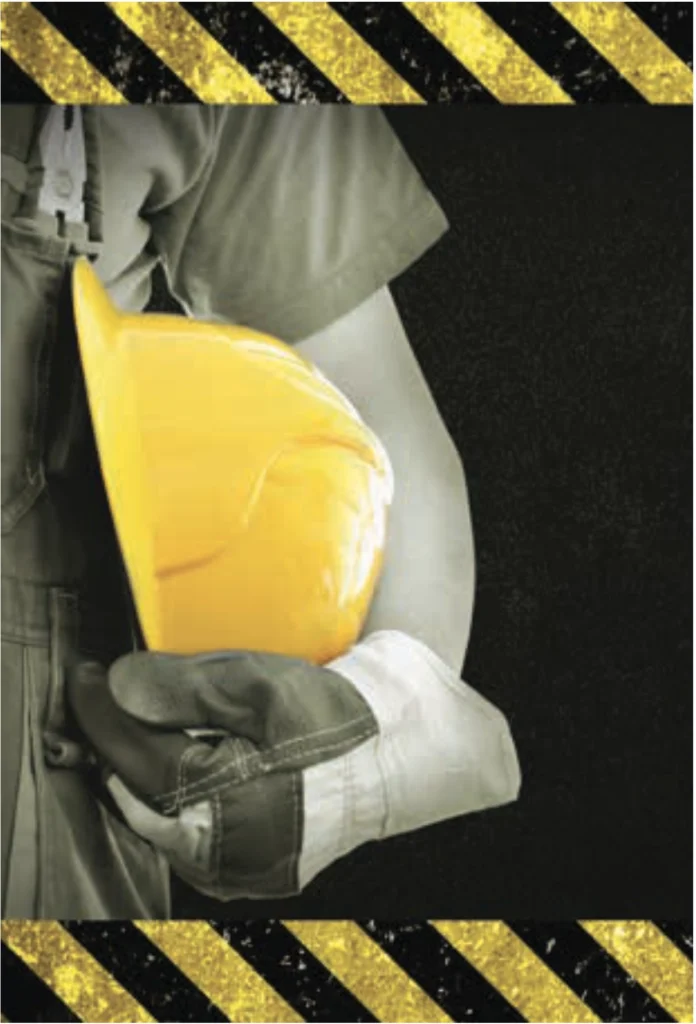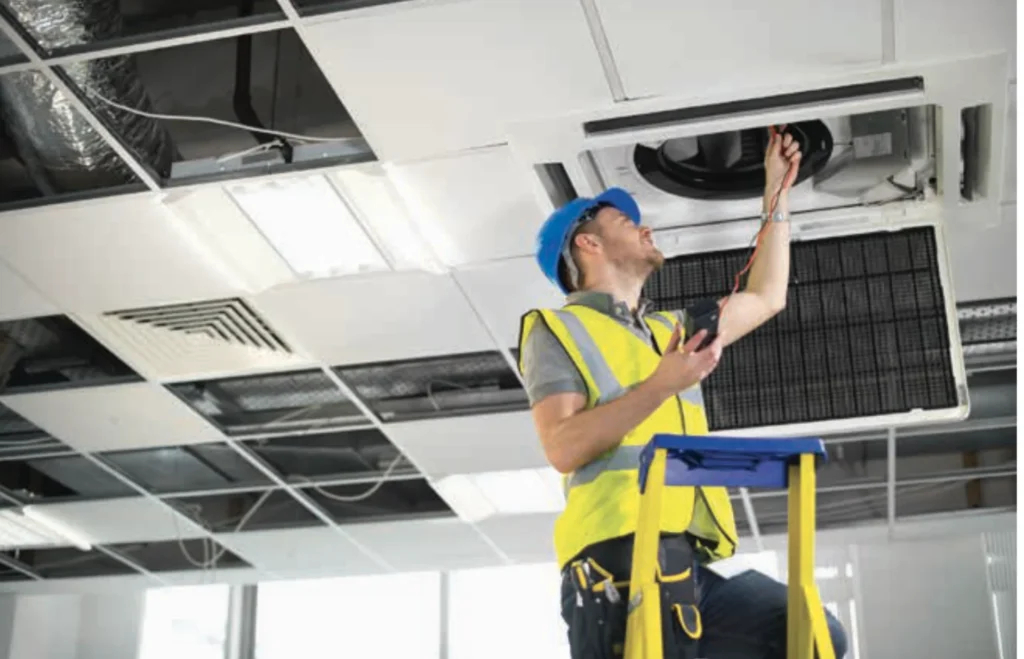By Todd Larson, on Jan 13, 2018, The NEBB Professional – Q1 2018 Edition
It happens. Accidents on the job.
No one is immune to unavoidable mistakes or worse, catastrophic incidents, and often jobsite safety is taken for granted. Logic dictates that if hardhats, goggles and gloves are on, first-aid kits and respirators are handy, CPR and egress routes are known, everything is covered. But it’s not.
The daily routine of work patterns can blind a professional to the nuances of site conditions that pose hidden threats to safety. Denial of potential safety issues contributes to more than 200 deaths and more than 1 million injuries annually as reported by Health and Safety Executive.

According to Greg Wharton, Safety Director for Sheet Metal Contractors Association of Philadelphia and vicinity, who conducts numerous safety training sessions yearlong, overall safety precautions and proper safety protocol can be some of the most under-rated aspects of the job, but the consequences for an individual and the company have the potential to be devastating.
“Safety gets overlooked in the workplace because of the critical nature of the business – everyone is moving fast to get the job completed, but it’s the small issues that can be life or death,” states Wharton. “The overarching concept about safety is to have employees going home the same way they went to work. Work together to go home together.”
Take the 2015 death of a 21-year-old plumbing contractor while replacing sewer line 11 feet below ground in Penn Township, Pennsylvania. The site’s unshored trench excavation collapsed and crushed him under 3,000 pounds of soil. The U.S. Department of Labor’s Occupational Safety and Health Administration (OSHA) cited his employer for nine violations of OSHA’s worksite safety standards, including failure to shield employees from unsteady earth and stone and failure to distance the cascading soil-pile at least two feet from the trench. The company owner faces up to $250,000 in fines, six months in prison, or both.
Another example is a 39-year-old HVAC installer who fell 15 feet through a metal roof’s skylight to his death on the building’s concrete floor when a co-worker accidentally bumped him while dislodging a saw from the roof. OSHA cited the Georgia-based electrical, mechanical and plumbing contractor for failure to follow the OSHA standard at 29 CFR 1926.501 (b)(4)i) that mandates the use of fall-arrest systems such as nets, harnesses, guardrails or hole-covers to protect workers from falling through openings over six feet above floors. Also charged with failure to report the accident to OSHA within eight hours of its occurrence, the contractor faced a $54,000 fine. William Fulcher, OSHA’s Atlanta-East Office area director, called the tragedy “preventable.”


These incidents are preventable with the Outreach Training Program in workplace safety and health that OSHA has offered companies of all types since 1971. The program, which includes 10-hour training for entry-level workers and more comprehensive 30-hour trainings for experienced workers and managers, teaches them how to identity, avoid, control and prevent jobsite hazards, and how to file a complaint to OSHA about an apparent worksite danger. Workers’ rights to jobsite safety, their rights as whistleblowers, and employers’ responsibilities for protecting their workers from harm on the job are also covered in the training. OSHA’s founding mission is to “assure safe and healthful working conditions for working men and women by setting and enforcing standards and by providing training, outreach, education and assistance.”
The program is voluntary in most states but mandated in Missouri, Nevada, New York, and, on certain types of worksites, Connecticut.
OSHA’s Outreach Training Program is especially critical for NEBB firms, many of which are smaller operations with as few as three to five technicians on staff. The loss of one worker from injury or death due to insufficient safety training hurts not only the worker but the firm, as firm leaders will attest.
“We have 22 employees, and losing a field technician would be a great loss,” said Harlan Rosenberg, president of Richard Flanders Enterprises, Inc., of Lauderhill, Florida, which is NEBB TAB certified. “OSHA made my people aware of the potentially unsate aspects of our jobs. For us, ladder safety, electrical safety, and confined space were the most pertinent areas.”
In the OSHA Training Program, a confined space is defined as “an area with small openings for a worker to enter and exit [that is not designed for regular work.” This includes manholes, sewer digesters, silos, pipeline passages, and crawlspaces containing HVAC equipment or boilers. Threats these spaces pose include: suffocation from lack of oxygen; excess oxygen that can support combustion of flammable substances in the space; excessive buildup of poisonous gases, heat, or cold; injurious noise that mandates the use of earplugs; physical hazards such as slipperiness, abrasiveness, or the presence of sharp or falling objects; or falling grain, gravel, sand or soil burying a worker alive, such as the plumbing contractor described above.
Before their 10-hour online training, Richard Flanders Enterprises technicians “had only minor injuries, mostly ladder accidents or bad cuts, as we do not do very hazardous work in testing and balancing,” said Rosenberg, who took the 30-hour online course. Because of the training, “we have not had an onsite accident for seven years,” due largely to refresher courses the firm follows to keep up with annual changes in OSHA workplace safety and health standards.
Pro Balance of Blue Springs, Missouri takes OSHA training very seriously since even if one worker was injured on the job, work progress stalls and lessens the manpower necessary to get the job done as a team. The stops or slowdown of work for accident investigation, increase medical and legal costs, all compromise the firm’s reputation.
Wharton agrees. “Whenever an employee is injured, it affects the firm’s ability to obtain jobs and influences the experience modification rate (EMR). Firms with a high injury rate make them less marketable and less desirable to work with,” states Wharton.
“We have 14 employees and losing one of them impacts us severely,” said Rick West, vice president of the NEBB-certified firm in HVAC testing and balancing for indoor air quality and duct leakage, air-barrier and building-envelope testing, and building systems commissioning. “General safety education, and understanding the impact of careless techniques reduces the risk of injury.”
Pro Balance’s primary safety concerns were electrical safety awareness regarding the level of voltage and amperage in HVAC equipment, as well as OSHA’s “slips, trips and falls” category related to the provision of safe ladders. All were fully addressed in the technicians’ 10-hour course and the safety officer’s 30-hour course the firm took with a trainer, followed by online refresher courses.
To conduct in-office safety trainings, a NEBB firm’s designated safety officer takes a special “train the trainer” course through the OSHA Training Institute (OTI) at one of 39 authorized OTI Training Centers throughout the nation, which include four safety councils and 32 universities, colleges and technology institutes. Depending on the nature of the firm’s services, the trainer must complete OSHA’s #500 Trainer Course in Occupational Safety and Health Standards for the Construction Industry or #501 Trainer Course in Occupational Safety and Health Standards for the General Industry to qualify to conduct the 10-hour or 30-hour employee trainings, and take refresher training courses every four years to maintain their trainer authorization.
For Climatech Inc., a Pittsburgh-based HVAC and refrigeration contracting firm of more than 150 NEBB-certified technicians, OSHA safety training has been especially valuable in ladder safety, confined spaces lacking oxygen or containing toxic or inflammable gases, large boiler system operation and on/off safety, electrical safety for units operating at upward of 460 volts, high-pressure refrigerant safety, provision of lone worker monitoring devices for proper vigilance on a technician working solo on a job or in a space, and lockout/ tagout (LOTO).
In LOTO, technicians are trained to padlock an electrical or boiler unit they have shut off and to tag it with a “Warning: Do not operate” sign with the technician’s contact information so the unit can be turned back on only with the technician’s authorization. The training also covered use of a safety data sheet (SDS) to learn what a chemical composition is (e.g., windshield-wiper fluid or antifreeze for a car), what its potential hazards are, and how to use it safely.

“Every manager in our company went thru the 10-hour OSHA training,” said Jacob Altland, a NEBB TAB CT at Climatech and standing member of its Safety Committee, who is now pursuing the 30-hour construction-industry training. “Our goal is to have all project managers obtain OSHA 30s. With so many employees, it’s been a large undertaking to make everything consistent and to get everyone on the same page.”
The OHSA 10-hour construction-industry courses cover include: common biological, chemical, ergonomic, physical and psychological health hazards; communication of hazards; characteristics of hazardous materials; safe use of cranes and rigging; awareness of electrocution hazards; avoidance of and protective guards against striking objects and machinery; entrapment in moving machinery or objects; protection from falls; the proper protective equipment to wear on the jobsite; safe use of hand and power tools; scaffold safety; safe passage along stairways and ladders; and OSHA site-inspection procedures.
The OSHA 30-hour construction-industry courses explore all the above, plus: fire and explosion protection; proper handling and storage of materials; welding and cutting; transportation and vehicle-related accidents; excavation site safety; concrete and masonry construction hazards; lead safety on the jobsite; proper use of explosives; and process safety management.
Climatech’s safety trainings have been conducted in-house by Safety Director Lee Fisher since he took his first OTI course at OSHA’s OTI Training Center at West Virginia University in 2005 to qualify to conduct the 10-hour and 30-hour trainings as an Outreach Training Program Trainer. “Throughout the course of year, I do supplemental training on various topics – ladder safety, aerial lift work, hazardous communication, welding — and I train our guys for an hour or two as a refresher,” said Fisher. “We also go over vehicle safety issues such as preparedness in the event of an accident or a flat tire, instances of getting hurt while operating machinery and what we can do to prevent that in the future, being burned by gas or exposed to it…a little bit of everything regarding the construction industry.”
To stay abreast of changes in OSHA safety standards, Fisher takes OSHA’s trainer update course every four years so he can conduct his year-round supplemental training with the most current safety regulations. “Supplemental training is ongoing since safety standards are always changing,” he said. “We have to keep up with those changes, but, ultimately we must instill in our people that safety matters to all involved.”

One standard OSHA recently updated for supplemental safety training is the respirable silica standard. “When we’re dealing with concrete drilling or cutting in a concrete foundation or on a highway, we need a vacuum system or wet-saw dust containment system to collect the dust and particulate the collection, whether its wet or dry, otherwise an OSHA inspector would penalize us,” said Altland. “Silica is the new asbestos.”
“Respirable silica is what you can’t see, so it was well thought out for upgrading, because a lot of fatalities are due to these situations,” added Fisher. “OSHA, as governing bodies for workers, do a good job at keeping up with the times, thoughtfully selecting a standard that needs to be updated. By putting out these standards and letting us train our workers in them, OSHA has reduced the amount of fatalities in this country every year.”
The OSHA Outreach Training Program benefits NEBB certified firms and individuals in many ways beyond worker safety and health.
- Insurance discounts may be available for firms that enroll in the program (firms should check with individual insurance providers).
- Workers’ compensation claims are reduced.
- Workers are more motivated by being assured of safety on every jobsite, now that everyone on the team follows all safety precautions.
- The OSHA seal of safety training assures clients of a firm’s reliability, productivity, and commitment to employee well-being.
- Above all, training in OSHA safety standards boosts firm morale by allowing buy-in from workers regarding maintenance of those standards.
“We put such precedence on safety that our employees take ownership of safety in the training provided,” said Fisher. “If employees buy into the culture and get their voice and opinion in it, it improves morale by giving them the power to instill that training into their daily work.”
Wharton concludes by stating the impact tenured employees have on apprentices cannot be underscored enough. As the adage goes, “Actions speak louder than words.”
“Veteran employees’ on-the-job behavior influences apprentices who mirror the actions they see. Veteran employees who do not comply with safety regulations, such as wearing safety glasses or appropriate fall protection, are culpable when apprentices mirror the behavior they see,” said Wharton. “The apprentice doesn’t know everything – and when they don’t follow proper protocols, injuries happen.”
When it comes to workplace safety – no one is invincible.